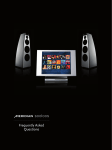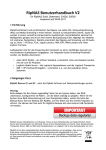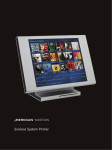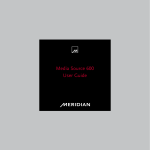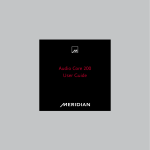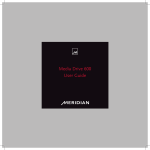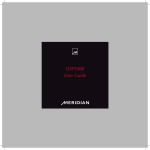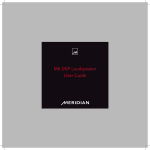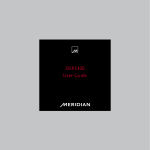Download Meridian Sooloos User guide
Transcript
Control Web / Mac / PC User Guide Control Web/Mac/PC Guide Meridian Sooloos Control Web/Mac/PC User Guide TABLE OF CONTENTS What is Control Web/PC/Mac?.....................................................................................................................3 Getting Started...................................................................................................................................................3 Playback Information and Controls.................................................................................................................4 Music Selection and Playlist Creation...........................................................................................................5 Editing Album Metadata....................................................................................................................................7 Deleting Albums............................................................................................................................................... 13 Importing Music............................................................................................................................................... 14 Exporting Music............................................................................................................................................... 19 Manual Backups and Restores.................................................................................................................... 23 Settings and Information................................................................................................................................ 26 Meridian Audio Ltd, Latham Road, Huntingdon, Cambridge PE 29 6YE , United Kingdom | www.meridian - audio.com 2 Control Web/Mac/PC Guide What is Control Web/PC/Mac? With Control Web, Control PC, and Control Mac you are able to operate your Sooloos system from a computer on the same network. With Control Web/PC/Mac, you can: • Select albums, tracks, and playlists for playback in any zone • Create, save, and delete playlists • Edit album metadata • Export albums to iTunes or any folder on your computer’s hard drive, including your phone or mp3 player (Control PC/Mac only) • Import music files and CDs (Control PC/Mac only) • Perform manual backups from a Twinstore or Ensemble to a computer hard drive or manually restore from a hard drive to a Twinstore or Ensemble (Control PC/Mac only) • Configure zone options including crossfade and volume leveling • Check system and library status • Turn any computer into a local playback zone for all of your music Although many of these features are available directly on the system, some, such as metadata editing, are more convenient on a PC. Some features, such as music export, backup, restore, and some import functions, are not available in Control Web and require installation of Control PC/Mac. Getting Started The first step is to make sure your computer and the Sooloos system are connected to the same network and that all Sooloos components are turned on. Then open your Web browser and enter the IP address of your Source or Ensemble — for example, http://192.168.1.6. (To find the correct address for your system, go to the Sooloos system’s Home Page and tap the Information button). Entering this IP address in the URL will access Control Web, the browser-based version of Sooloos control, which works for all functions except music export and import. It supports Internet Explorer, Safari, and Firefox, on Windows, Mac, and Linux operating systems. Meridian Audio Ltd, Latham Road, Huntingdon, Cambridge PE 29 6YE , United Kingdom | www.meridian - audio.com 3 Control Web/Mac/PC Guide If you need full functionality of import and export, then you must install Control PC or Control Mac on either a Windows or Macintosh computer. To install the full version of Control, access Control Web and then click the Import or Export tab. Control Web will prompt you to download and install the version you need – either Control PC for Windows-based computers or Control Mac for Apple Macintosh computers. Once you have installed this application, you probably will find it more convenient than the browser-based version, regardless of which functions you are using, as running it does not require looking up the Source or Ensemble IP address, which may change from session to session. It is still essential that the computer and the Sooloos system be connected to the same network router and that all components of the Sooloos system be turned on, however. Once Control PC is running, you will notice that Windows Explorer shows an S: drive on your computer. On a Macintosh, you will find a “Sooloos” network volume on your desktop. This is a virtual hard drive that gives access to all of the music, playlists, and tags on your Sooloos Store or Ensemble, which your computer now sees as a networked external hard drive. If Control Web, PC or Mac fails to run, the most likely reason is a network problem, since it must communicate intensively with the Sooloos system in order to function. If you are running the Control Web in your web browser, check to be sure you have entered the correct IP address (which may not be the same as it was the last time you ran it). Also check cables. If you find no obvious problems such as these, try shutting down everything on the network and rebooting the router. Restart the Sooloos system and your computer, then launch Control again. If the problem persists and your computer talks to the router via WiFi, try making an Ethernet connection instead, since wired connections are more reliable. If you have an old router, or one supplied by your internet service provider (ISP), replacing it with a new one may also help. Playback Information and Controls The top part of the screen remains the same in all modes, providing basic information about the currently playing track (if any) and the current playlist, as well as standard playback controls. Controls include, from left to right: • Transport. Play, pause, or stop the currently selected track, or skip to the next or previous track in the playlist. • Track Time Slider. A graphical indicator of progress through the currently playing track, with elapsed time displayed at the left and remaining time at the right. You can grab the time marker with your mouse and scrub it forward or backward to resume playback at a different point. Meridian Audio Ltd, Latham Road, Huntingdon, Cambridge PE 29 6YE , United Kingdom | www.meridian - audio.com 4 Control Web/Mac/PC Guide • • • Volume Control. You can click the +/− buttons to vary the analogue audio output for the currently selected zone, from a maximum of 100 (full on) to a minimum of 0 (full off). Mute. Clicking the mute button toggles the audio output off or on. Zone Selection. Choose the zone being controlled from the dropdown list at the top right. (For more on zone configuration, see “Settings and Information,” page 26.) Multiple zones can have separate playlists running simultaneously. Available zones include all those provided by Controls, Sources or Ensembles in the system. Note: You will also have the option of “Local Playback Zone.” Selecting this zone will route sound to the speakers of the computer you are using to access the system. Music Selection and Playlist Creation The applications open in the Music tab, where you can choose music for playback in the current zone (selected using the dropdown at the top right of the screen), create and save playlists for future use, and edit previously saved playlists. The bottom part of this screen comprises two panes. The top pane displays the tracks in the current playlist, including the albums they come from, their lengths, and whether they have played yet, together with controls for manipulating the list. The bottom pane is a browser for adding music from your collection to the playlist. To change the relative sizes of the two panes, just grab the separator (it has a small dot in the middle) with your mouse and slide it up or down. Meridian Audio Ltd, Latham Road, Huntingdon, Cambridge PE 29 6YE , United Kingdom | www.meridian - audio.com 5 Control Web/Mac/PC Guide Music Selection Use the windows at the bottom of the screen to browse your collection and add music to the playlist. Begin by clicking one of the six categories in the far-left window: Artists, Playlists, Tags, Genres, Decades, or Recently Imported Albums. Your selection will expand to a new set of options in the window to the right. (The playlists and tags categories will expand only if you have previously created at least one Playlist or Tag.) For example, if you click Artists, the second window will list a set of alphabetical ranges. Clicking one of these opens a list of artists whose names start with a letter in that range (ignoring “The” and “A”) in the third window. If you then click an artist, the open windows will shift to the left and a fourth will open with a list of albums by that artist. Clicking an album will shift the open windows to the left again to open a fifth with a list of songs on that album. (If you need to get back to a now-hidden window, click the single left arrow at the bottom left of the screen to scroll back one window or the double left arrow to jump all the way back to the first window.) The Albums window displays a button next to each entry. Clicking one of those buttons will bring up a window with a list of playback options for you to select from. The list presented when you click a button will depend on the category you’re in. Tags, Genres, and Decade offer different options than Albums and Songs for example. Options offered may include: • Show Album Details (Albums). Detailed information about the album. This window also offers options to delete the album from the system (see “Deleting Albums,” page 13) or edit its information (see “Editing Album Metadata,” page 7). • Queue (Albums and Songs). Add to the end of the Playlist. • Play Next (Albums and Songs). Insert in the Playlist after the current track. • Play Now (Albums and Songs). Insert after the current track and begin playing immediately. • Queue Album Picks (Albums). Add the album’s best tracks to the Playlist. (For more on Album Picks, see “Editing Album Metadata,” page 7.) Meridian Audio Ltd, Latham Road, Huntingdon, Cambridge PE 29 6YE , United Kingdom | www.meridian - audio.com 6 Control Web/Mac/PC Guide • • • • • • Play Album Picks Next (Albums). Insert the album’s best tracks into the Playlist after the current track. Play Album Picks Now (Albums). Insert the album’s best tracks into the Playlist after the current track and begin playing them immediately. Replace Playlist (Playlists). Replace the current Playlist with the contents of the selected Playlist. Append to Playlist (Playlists). Add the contents of the selected Playlist to the end of the current Playlist. Delete (Playlists and Tags). Delete the Playlist or Tag. (This does not delete the music associated with the Playlist or Tag from the system, only the listing.) Swim (Tags, Genres, and Decades). Automatically choose and play music from albums associated with the selected Tag, Genre, or Decade. Working the Playlist Along the bottom of the Playlist window in the middle of the screen are six control buttons: • Shuffle. Clicking this button toggles Shuffle on or off. When it is on, the tracks in the Playlist play in random order. • Loop. Clicking this button toggles Looping on or off. When it is on, the Playlist will repeat instead of stopping at the end. If you check both Loop and Shuffle, all songs in the Playlist will play before it starts over (in a new order). • Remove. Clicking this button pops up a menu with options for removing played tracks from the Playlist or all tracks from the Playlist. If you have highlighted any tracks with your mouse, you will also have an option to remove the selected tracks. (If a song is playing, you must stop it before you can remove it.) • Down/Up. Moves a highlighted track (or group of tracks) down or up in the Playlist. • Deselect. Clears highlighting of any previously selected tracks. You can jump directly to any track in the playlist by double-clicking it. Editing Album Metadata The system stores metadata for each album, normally downloaded from the Sooloos Metadata Service. It contains a variety of information, including track titles, artist credits, genres, record label, rating, and so forth. You can modify that data or enter your own. The edit-metadata function launches from the Album Details window. Click the Play tab to enter the music manager and use the browsing pane at the bottom of the screen to locate the album you want to work on (see “Music Selection and Playlist Creation,” page 5). Then click the button at the right of the album name and choose Show Album Details in the pop-up window to bring up the Album Details window: Meridian Audio Ltd, Latham Road, Huntingdon, Cambridge PE 29 6YE , United Kingdom | www.meridian - audio.com 7 Control Web/Mac/PC Guide Clicking the Edit Album button at the bottom left of the window opens a new Edit Album Information window containing the metadata. (Be patient — this may take some time.) Clicking the X in the upper right-hand corner closes the window. The metadata is organized into eight sub-pages, selected by clicking the tabs along the top. Important Note: All changes are provisional until you click the Save button at the bottom of the window. If you close the window (by tapping the X in the upper right-hand corner of the window) without clicking Save, your edits will be lost. Info The Edit Album window opens in this tab. Manual editing on this page is mostly a matter of typing new information into the available fields, but a number of items work distinctively: Meridian Audio Ltd, Latham Road, Huntingdon, Cambridge PE 29 6YE , United Kingdom | www.meridian - audio.com 8 Control Web/Mac/PC Guide • • • • Album Pick. A gold star to the right of the album name field indicates an Album Pick — a favorite album that will be included in Focuses or Swims specifying Album Picks only. An X indicates an album that will not normally be included unless it is specifically selected. A dark star represents a middle ground — an album that is singled out neither for inclusion or rejection. You can change this rating by clicking on the star or X to toggle through the three options. Rating. Click the + or − button at either end to adjust the album rating in half-star increments from 0 to 5. Multi-Disc Set. Important for keeping track of the contents of the individual discs in a multidisc set. The second disc of a three-disc set would be listed as “2 of 3,” for example. Cover. You can delete the existing cover image by clicking the Clear Cover button. And you can replace it by dragging or copying an image from your hard drive or Web browser into the space. Tracks This page enables you to change information about the tracks on an album, including, left to right, track numbers, track titles, and Track Pick ratings. (Track times are also listed but are not alterable.) Remember that all changes are provisional until you click the Save button at the bottom of the window to make them permanent. Tapping the X in the upper right corner closes the window and cancels any unsaved changes. To change a Track Pick rating, click on the symbol to the far right to toggle through the three options: gold star (a favorite track that will be included in a playlist when you choose Track Picks only), X (a track that will be excluded unless specifically chosen), or dark star (a track that will be included when no restrictions are applied). Review This is a freeform text field that you can edit or rewrite. All changes are provisional until you click the Save button at the bottom of the window to make them permanent. Tapping the X in the upper right corner closes the window and cancels any unsaved changes. Genres, Credits, and Moods The information contained in the panels opened by these tabs is important for the Sooloos Focus feature, which enables you to narrow the selection of music to be browsed or played according to particular characteristics. As always in the Edit Album window, changes are provisional until you click the Save button at the bottom to make them permanent; tapping the X in the upper right corner closes the window and cancels any unsaved changes. Meridian Audio Ltd, Latham Road, Huntingdon, Cambridge PE 29 6YE , United Kingdom | www.meridian - audio.com 9 Control Web/Mac/PC Guide Genres Clicking the Genres tab switches the panel to a list of standard genre, subgenre, and style (subsubgenre) categories on the left and styles already associated with the album on the right. Clicking the button next to a genre listing expands to a listing of all its subgenres, and clicking the button next to a subgenre listing expands to a listing of all its styles. (Clicking the button collapses a list.) To associate a style with the album, click the button to its right. Note that associations must be at the style level. To dissociate a style, go to the pane’s right-hand column and click the right. button to the style’s Meridian Audio Ltd, Latham Road, Huntingdon, Cambridge PE 29 6YE , United Kingdom | www.meridian - audio.com 10 Control Web/Mac/PC Guide It is also possible to create a new style. Start by clicking the Add New Style button at the bottom left, which will open the Create a Style window. Locate the new style’s genre on the list and click the button to expand to a list of subgenres. Highlight the new style’s subgenre with your mouse. Then type the new style’s name in the field at the bottom of the window and click the Create button. The window will close, and the new style will now appear under the chosen subgenre in the Edit Album Information window. To close the window without adding a new style, just click the X at the upper right. Credits Clicking the Credits tab switches the panel to a list of credits for the album. Meridian Audio Ltd, Latham Road, Huntingdon, Cambridge PE 29 6YE , United Kingdom | www.meridian - audio.com 11 Control Web/Mac/PC Guide To add a new credit, enter the person’s name in the Credit Name field and his or her role (e.g., “Lead Guitar” or “Producer”) in the Credit Role field. Then click the Add Credit button at the right, and the new credit will appear at the bottom of the list. To remove a credit, just click the button to its right. Moods The Moods tab switches the panel to a list of moods, which you select or deselect by clicking the checkboxes next to them. Labels Clicking the Labels tab switches the window to a listing of record labels associated with the album. To associate a new label with the album, enter its name in the Enter Labels field at the top of the window. As you type, a list of labels already in the system that contain the sequence of letters you’ve typed will pop up, and if the label is in that list you can simply highlight it with your mouse. Meridian Audio Ltd, Latham Road, Huntingdon, Cambridge PE 29 6YE , United Kingdom | www.meridian - audio.com 12 Control Web/Mac/PC Guide Save the label by clicking the Add button to the right, and it will appear at the bottom of the list. (An album can have multiple labels associated with it.) To dissociate a label, click the button to its right. All additions or deletions are provisional until you click the Save button at the bottom right. Clicking the X in the top right-hand corner will close the window, canceling any unsaved changes. Tags Clicking the Tags tab switches to a window that lists available Tags and enables you to control their association with the album, as well as to create new Tags. (A Tag is a user-created category — “Dad’s Favorites”, for example, or “Party Music” — that can be a basis of a Focus.) All changes are provisional until you click the Save button at the bottom of the window to make them permanent. Tapping the X in the upper right corner closes the window and cancels any unsaved changes. Any Tag in the list already associated with the album will have a checkmark in the box to its left. To associate or dissociate a Tag, just click the box next to it to toggle the checkmark on or off. (When a Tag is no longer associated with any album in the Media Library, it will cease to exist and disappear from the list altogether.) You can also create a new Tag associated with the album by typing a unique name in the field above the list and clicking the Add button to its right. Deleting Albums The Album Details page for each album offers the option of removing the album from the system. (Note that there is no undo procedure for this function; once you confirm deletion, the only way to get an album back is to reimport it.) Click the Play tab to enter the music manager and use the browsing pane at the bottom of the screen to locate the album you want to delete (see “Music Selection and Playlist Creation,” page 5). Then click the [image] at the right of the album name Meridian Audio Ltd, Latham Road, Huntingdon, Cambridge PE 29 6YE , United Kingdom | www.meridian - audio.com 13 Control Web/Mac/PC Guide and choose View Album Details in the pop-up window. This will bring up the Album Details window. Clicking the Delete Album button at the bottom right of the window brings up a dialog box asking you to confirm that you want to remove the album from the system. Clicking “OK” at this point deletes the album; the only way to recover it after that is to reimport it. Clicking “Cancel” returns you to Album Details. Clicking the X in the upper right-hand corner closes the window. Importing Music NOTE: You must install Control Mac or Control PC to use import functions. In the import tab, you can import MP3 music files from your computer or CDs from your computer’s CD or DVD drive. Begin by clicking the Import tab, which will switch to the import screen (top of screen shown below). Meridian Audio Ltd, Latham Road, Huntingdon, Cambridge PE 29 6YE , United Kingdom | www.meridian - audio.com 14 Control Web/Mac/PC Guide Import Settings Click Import Settings, at the upper left of the page, to open the Import Settings window. This dialog offers five options, which you can toggle on or off by clicking the checkbox to the left: • Enable SecureRip. Forces multiple retries when the drive initially fails to read an area of a CD properly because of scratches or smudges. This may reduce the number of uncorrectable errors when importing soiled or damaged discs, but the process will be slower. (We recommend leaving this box checked.) • Skip duplicate albums. Prevents import of albums already on the system. If this is not checked, the system will still warn if you are about to import a duplicate. • Automatically approve albums with complete metadata. If the system locates full metadata for the album on the Sooloos servers, it imports the CD without requesting confirmation. • Prefer local metadata over Sooloos Metadata Service. Will use existing metadata for files imported from your computer in preference to metadata available from Sooloos. • Automatically remove completed projects. Removes album titles and transfer-progress bars for imported CDs as soon as the imports are completed successfully. Clicking the X at the upper right closes the window. Importing CDs To import a CD via your computer’s CD or DVD drive, click the Import CD button at the top of the page. If you have not already loaded the CD, you will be prompted you to do so. After you have inserted the disc, the system will contact the Sooloos Metadata Service and look for information about the album. It will then pop up a window indicating what it found and, unless you clicked “Automatically approve albums with complete metadata” in , ask you how to proceed. Meridian Audio Ltd, Latham Road, Huntingdon, Cambridge PE 29 6YE , United Kingdom | www.meridian - audio.com 15 Control Web/Mac/PC Guide Click the Approve button to import the CD and its metadata as-is, the Edit button to open the Edit Album Information window (see “Editing Album Metadata,” page 7), or the Unalbumize button to cancel the import. Once you’ve approved an import, a progress window will open. The system starts extracting data from a CD in the background as soon as it recognizes it, so the progress window may come up indicating some portion of the transfer is already complete. Each CD you import displays as a separate transfer-progress bar, with its title at the top. Once you’ve finished all imports for a session, click Clean Up List to clear all the bars. To remove an individual transfer-progress bar while leaving the others, click the X at its top right. Importing Folders It is also easy to import music files already organized into folders (in an iTunes library, for example). Click the Import Folder button, and a Browse for Folder window will pop up. Meridian Audio Ltd, Latham Road, Huntingdon, Cambridge PE 29 6YE , United Kingdom | www.meridian - audio.com 16 Control Web/Mac/PC Guide Locate and click the folder containing the files you want to import, then click the OK button at the bottom of the window. (The folder can contain subfolders, and the application will sort that out. You could import an entire MP3 music library at once this way if you wanted to.) The application will send information about the files to the Sooloos Metadata Service. If the files in the folders correspond to the contents of recognizable albums, it will organize them accordingly, apply the downloaded metadata, and prompt you to evaluate, and approve them. Clicking the Approve button will import the files and their metadata to the system as an album. If you disagree with the information that has been downloaded, clicking the Edit button will open the Edit Album Information window (see “Editing Album Metadata,” page 7). If you don’t want to group the tracks into an album, clicking Unalbumize button will move them to the loose files bin (see below.) If the system does not recognize files as comprising all or part of an album, or if you choose the Unalbumize option, it will list them individually in a Loose Files pane at the bottom of the page. (You can resize the pane by grabbing the separator bar — it has a small dot in the middle — with your mouse and dragging it up or down.) Meridian Audio Ltd, Latham Road, Huntingdon, Cambridge PE 29 6YE , United Kingdom | www.meridian - audio.com 17 Control Web/Mac/PC Guide The function of this pane is to enable you to assemble albums from groups of files. At its top right are two buttons: Clear Loose Files and Create Album from Selected Files. Clicking the Clear Loose Files button does exactly that — clears any remaining files from the pane. Clicking the Create Album button assembles an album from any files you’ve highlighted with your mouse and pops up the same window seen when importing a CD or folder. In this case, however, it’s less likely that the Sooloos Metadata Service will have metadata available for the newly created album. (If it did, you probably wouldn’t be assembling the album manually to begin with.) So you usually will want to click the Edit button to open the Edit Album Information window and enter metadata. At the very least, you’re going to want the album to have a title so you can locate it easily later. The system will import WAV, FLAC, AAC, AIFF and MP3 files up to 24-bit/96kHz sampling. Importing Individual Files If you download individual files on your computer and want to import them to the system, click the Import Files button, and a file browsing window will pop up. Navigate to the folder containing the files you want to import. Highlight the files you want with your mouse, then click the Open button at the bottom of the window. The application will then list them in a Loose Files pane at the bottom of the Import page. (You can resize the pane by grabbing the separator bar — it has a small dot in the middle — with your mouse and dragging it up or down.) Meridian Audio Ltd, Latham Road, Huntingdon, Cambridge PE 29 6YE , United Kingdom | www.meridian - audio.com 18 Control Web/Mac/PC Guide This pane enables you to assemble albums from groups of files, whether related or unrelated. At its top right are two buttons: Clear Loose Files and Create Album from Selected Files. Clicking the Clear Loose Files button does exactly that — clears any remaining files from the pane. Clicking the Create Album button assembles an album from any files you’ve highlighted with your mouse and sends information about it to the Sooloos Metadata Service. If the files correspond to the contents of a recognizable album, Control:PC will download the associated metadata and prompt you to import the files. Click the Approve button to import the files and their metadata as an album, the Edit button to open the Edit Album Information window (see “Editing Album Metadata,” page 7), or the Unalbumize button to dissolve the album and re-list its contents in the Loose Files pane. Since it’s relatively unlikely that an album created in this manner will correspond to a commercial release, you usually will need to click the Edit button to open the Edit Album Information window and enter metadata. At the very least, you’re going to want the album to have a title so you can locate it easily later. The system will import WAV, FLAC, AAC, and MP3 files up to 24-bit/192kHz sampling. Exporting Music NOTE: You must install Control Mac or Control PC to use export functions. Control PC or Control Mac can export music from your Sooloos system to an iTunes Library, to a folder on your computer’s hard drive, or to an MP3 player. (The exported files will be in 192kb/s MP3 format.) Begin by clicking on the Export tab, which will switch you to the music-export screen. Meridian Audio Ltd, Latham Road, Huntingdon, Cambridge PE 29 6YE , United Kingdom | www.meridian - audio.com 19 Control Web/Mac/PC Guide Click the Export Music to iTunes Library button to export to iTunes or the Open Sooloos Volume button to export to a folder or player. Export to iTunes You can export music to iTunes either as links or as files. Exporting links requires no storage on your computer, but the music is accessible through iTunes only when the Sooloos system is running. Exporting the files themselves takes up space on your hard drive, but they are available in iTunes regardless of whether the Sooloos system is on. You choose the type of export as a preference in iTunes (not Control PC or Control Mac). Start iTunes and select Preferences from the Edit menu. Then click the Advanced tab. Meridian Audio Ltd, Latham Road, Huntingdon, Cambridge PE 29 6YE , United Kingdom | www.meridian - audio.com 20 Control Web/Mac/PC Guide Check the box to the left of “Copy files to iTunes Music folder when adding to library” if you want to physically transfer the files; uncheck the box if you want to export just links to the files on the Sooloos system. Note: Do not attempt to use iTunes while exporting music to it. If you have iTunes open, make sure it is not in the iTunes Store, then minimize it before starting the export. Begin the export by clicking the Export Music to iTunes Library button on the Sooloos export page, which will open the iTunes Export window. Use your mouse (click the appropriate radio button) to select whether you want to export all the albums in your collection or only those associated with selected Focuses or Tags (all saved Focuses and Tags are listed in the two panes directly below). If you choose the latter, you must check the boxes next to the Focuses and Tags you want to include. Meridian Audio Ltd, Latham Road, Huntingdon, Cambridge PE 29 6YE , United Kingdom | www.meridian - audio.com 21 Control Web/Mac/PC Guide Once you’ve finished your selection, click the Run Export button at the window’s bottom right to export the files. The window will close, and the export-progress bar will appear. To cancel without exporting, click the Cancel button at the bottom of the window or the X in the top right-hand corner. And if you want to remove previously exported music from the iTunes library, click the Remove All Exported Music from iTunes button at the window’s bottom left. Export to a Folder or Player You can export music from the Sooloos system to a folder on your hard drive or to a portable player/phone simply by copying the files from your Sooloos volume to the destination on your computer. Begin by clicking the Open Sooloos Volume button on the Export page. This will open a Finder window on a Macintosh, or a Windows Explorer window in the S: drive, which is how your Sooloos Store appears to a PC. Open the music folder and you’ll find four subfolders: Artists, Focuses, Playlists, and Tags. The Artists folder contains subfolders for each artist represented in your Media Library, and each of those contains album subfolders that hold the actual music files. The other three main folders contain subfolders for your various saved Focuses, Playlists, and Tags, which in turn hold M3U and PLS files associated with them. Use your mouse to highlight the files you want to export and copy them to the target location or device. M3U files are standard playlist files used by most portable devices. Copying an M3U file to a phone/player will prompt the copying of the audio files that accompany it. PLS files are used by Zune players and will act as M3U files when accessed for a Zune. Meridian Audio Ltd, Latham Road, Huntingdon, Cambridge PE 29 6YE , United Kingdom | www.meridian - audio.com 22 Control Web/Mac/PC Guide Manual Backups and Restores NOTE: You must install Control Mac or Control PC to use Manual Backup/Restore functions. Control PC and Control Mac can back up the contents of a Twinstore or Ensemble to a hard drive in or attached to your computer (or to your network), as well as restore previously backed-up data from a hard drive to a Sooloos system. Start by clicking the Backup tab, which will bring up screen with two buttons. Backup Start a backup by clicking the Run Backup Wizard button. This will open the Backup window, which will prompt you to select a backup location. If the location you want does not appear in the dropdown, click the box to its right to open a Browse for Folder window. Find or create the folder you want to use for the backup and click OK. Then click the Next button in the Backup window to proceed to the next step. Meridian Audio Ltd, Latham Road, Huntingdon, Cambridge PE 29 6YE , United Kingdom | www.meridian - audio.com 23 Control Web/Mac/PC Guide Use the appropriate radio button to select whether you want to backup all the albums in your collection or only those associated with selected Focuses or Tags (all saved Focuses and Tags are listed in the two panes directly below). If you choose the latter, you must click with your mouse to check the boxes next to the Focuses and Tags you want to include. Once you’ve finished your selection, click the Run Backup button at the window’s bottom right to begin copying the files. The window will close, and the backup will proceed in the background. To go back to a previous step, click the Back button. To cancel before starting a backup, click the Cancel button at the window’s lower left or the X at its upper right. Restore To restore all or part of your Sooloos Media Library, click the Run Restore Wizard button. This will open the Restore window, which will prompt you to choose a backup to be restored. If the location of the backup you want to use does not appear in the dropdown, click the button to its right to open a Browse for Folder window. Meridian Audio Ltd, Latham Road, Huntingdon, Cambridge PE 29 6YE , United Kingdom | www.meridian - audio.com 24 Control Web/Mac/PC Guide Once you’ve found and selected the folder you want to restore from, click the Next button at the bottom right of the Restore window. The window will then switch to a listing of items that can be restored from the selected folder. Each item will have a checkbox to the left of it. For those not present on the Sooloos system, the box will already be checked. If there are any of those you don’t want to restore, click on their boxes to uncheck them. You may also click unchecked boxes to include items not pre-selected, but this will result in the backup files overwriting corresponding files already on the system (which you may want to do if the files on the system are corrupt or incomplete for some reason). Once you’ve finished choosing the items to be restored, click the Run Restore button at the window’s bottom right. The window will close, and the restore-progress indicator will appear. To go back to a previous step, click the Back button. To cancel before starting a restore, click the Cancel button at the window’s lower left or the X at its upper right. Meridian Audio Ltd, Latham Road, Huntingdon, Cambridge PE 29 6YE , United Kingdom | www.meridian - audio.com 25 Control Web/Mac/PC Guide Settings and Information System information and configuration options are located under the Settings tab. Clicking it brings up a screen like the one below. Local Playback Zone Bitrate Use the dropdown to adjust the data rate of music sent from the Sooloos system for playback on the computer speakers, from 64 to 192 kilobits per second (kbps). In most cases there will be no reason to change from the default of 192 kbps, but if you experience dropouts because of high traffic on your network, try ratcheting down to a lower data rate. Zone Configuration To edit a zone’s configuration, click the Configure button to the right of its name on the list. That will bring up a Configure Zone window. Meridian Audio Ltd, Latham Road, Huntingdon, Cambridge PE 29 6YE , United Kingdom | www.meridian - audio.com 26 Control Web/Mac/PC Guide The following settings are available: • Zone Name. Enter whatever identifying name you like. • Link Zones. Clicking this button pops up a window in which you can select another zone as the master for the one you’re configuring. Then whatever playlist is set up for the master zone will apply to the slave zone as well, which can be handy for parties, to take one example. You can link and unlink zones whenever you want. • Volume Leveling. The system can even out the peak level from album to album or track to track, preventing abrupt volume changes. To ensure best sound quality, Sooloos applies an intelligent volume adjustment at the start of each album or song rather than compression. Click the radio button to the left of your preferred option: Off, Song (volume adjustment from track to track), or Album (volume adjustment from album to album). • Gain Adjustment. The master volume setting for the zone. You may find it convenient to turn this down for a zone with unusually sensitive speakers or where lower levels typically are desired. • Crossfade. Length of the crossfade between tracks, adjustable from 0 (Off) to 10 seconds. Select the period you desire from the dropdown list. Settings do not take effect until you click the Apply button at the bottom right. Clicking the Cancel button closes the window without making any changes. Meridian Audio Ltd, Latham Road, Huntingdon, Cambridge PE 29 6YE , United Kingdom | www.meridian - audio.com 27



























